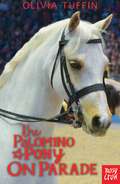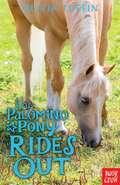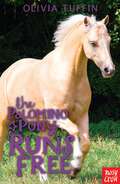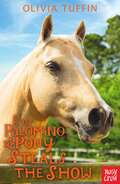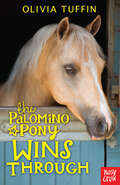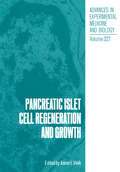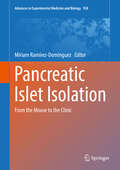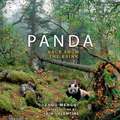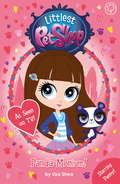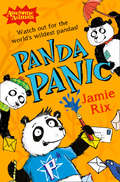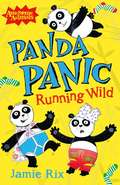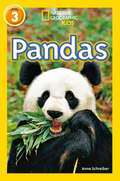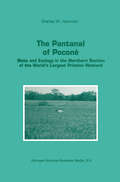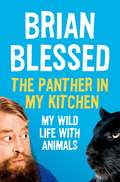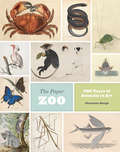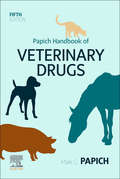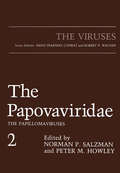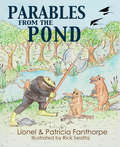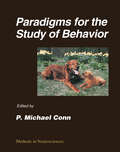- Table View
- List View
The Palomino Pony on Parade (The Palomino Pony)
by Olivia TuffinPerfect pony books full of action and adventure!Georgia is fantastically excited to be competing at Olympia! It's like a dream come true, and she's really looking forward to it. Especially the Parade at the end, where she can show off her gorgeous little palomino, Lily, to the world!
The Palomino Pony Rides Out (The Palomino Pony #2)
by Olivia TuffinPerfect pony books full of action and adventure!Life for Georgia has been pretty much perfect since the little palomino pony, Lily, came to Redgrove Stables. And now Lily's expecting a foal and Georgia has been asked to try out for the Championship team! If only her best friend, Emma, shared her excitement. But she's too busy being friends with the new girl at school... Can Georgia stop feeling jealous? If only Emma were as loyal as Lily...
The Palomino Pony Runs Free (The Palomino Pony #4)
by Olivia TuffinPerfect pony books full of action and adventure!Georgia and her beautiful palomino pony, Lily, are hoping to make it to the Horse of the Year Show. It's a big dream and it'll take a lot of work from both of them. Georgia isn't sure she's good enough and it's affecting how she rides. How she feels about everything, in fact. It's almost as if Georgia has forgotten why she loves riding. Can Lily help her remember that it's not just about competing and winning trophies, but about the joy of running free...
The Palomino Pony Steals the Show (The Palomino Pony #0)
by Olivia TuffinPerfect pony books full of action and adventure!Georgia and her Palomino, Lily, have come a long way together but now, in their final adventure together, they face what might just be their biggest challenge yet. Georgia and Lily have been selected for dressage training camp at Rosefolly Equestrian Centre, the best equestrian centre in the country, where they will compete for a place on the British Pony Squad. Georgia can't wait to show off Lily's abilities at Rosefolly, and she's so happy to be training alongside friendly Jodie and her beautiful but skittish pony, Jackson. But it looks like stuck-up Serena wants to make an enemy of both of them. She's desperate to win a place on the squad, and she won't let anyone stand in her way...
The Palomino Pony Wins Through (The Palomino Pony #3)
by Olivia TuffinPerfect pony books full of action and adventure!Georgia couldn t be more thrilled when she is asked to ride some top show-horses over the Easter holidays. She even gets to take Lily and her gorgeous foal, Secret, to the new stables. But who is the strange girl who keeps causing trouble for them on the show circuit? Can Georgia get to the bottom of it all? Surely no one would want to harm the little palomino pony?
Pancreatic Islet Cell Regeneration and Growth (Advances in Experimental Medicine and Biology #321)
by Aaron I. VinikAaron I. Vinik, M.D., Ph.D. I IEastem Virginia Medical School The Diabetes Institutes Norfolk, Virginia 23510 This symposium, held in June 1991, was a gathering of international scientists to exchange their views on current concepts of cell growth and differentiation. Each scientist was asked to present a topic of their research related to cell growth and regeneration and to participate in a round table conference elaborating on current knowledge and sharing their experiences. By furthering this promising area of endeavor, a means of understanding ontogeny of cell development and of providing insights into tumor biology would prevail. Of prime importance was the anticipation that new information from a better understanding of the normal evolution of the pancreatic islet would generate alternative approaches to curing diabetes. This forward serves as a short introduction to the concept of pancreatic islet regeneration and the models currently in use to study the process. DEVELOPMENTAL ORIGIN OF ISLETS DURING EMRYOGENESIS The developing pancreas appears as a protrusion from the dorsal surface of the l embryonic gut. The different islet cell types appear sequentially during development in vivo. It therefore seems reasonable to propose that coordinated growth is dependent upon specificity of growth factors.
Pancreatic Islet Isolation: From the Mouse to the Clinic (Advances in Experimental Medicine and Biology #938)
by Miriam Ramírez-DomínguezPancreatic islets make up the endocrine pancreas and they contain the only source of insulin in the body, beta cells. Hence, access to high quality preparations of pancreatic islets is fundamental for in vitro studies and to test pre-clinical applications in animal models in vivo. Access to healthy human islets is also crucial to improve transplantation procedures for diabetes. Given the susceptibility of pancreatic islets to the enzymatic digestion and mechanical stress required to obtain them, the isolation of islets is often considered as the delicate “work of a craftsman”. This book, which is aimed at beginners and experts alike, is a survey of the current state-of–the-art in this field and it centres on the challenges, pitfalls and peculiarities of pancreatic islet isolation in the different species used in pre-clinical and clinical applications. It explores the similarities and differences between human islets and those from other relevant species (rodents, pigs and non-human primates), and how these influence islet isolation. The ultimate goal of this book is to improve the outcome of islet isolation and transplantation in pre-clinical and clinical applications.
Panda: An Intimate Portrait Of One Of The World's Most Elusive Characters
by Heather AngelWith its large, friendly face and eyes exaggerated by black eye patches, China's national treasure, the giant panda, is instantly recognizable.Giant pandas spend most f their time trying to eat enough bamboo to survive. The rest is spent conserving energy, and solitary pandas can be seen strolling along, stopping to recline on riverside rocks or amongst ferns. The lower body-weight and physical size of panda cubs mean that they have more energy to spend, and are seen climbing trees, play-fighting, doing somersaults and playing with bamboo.Panda is a unique and intimate portrait of one of the world's best-loved animals. The extraordinary lives of the giant panda and the enchanting red panda are captured throughout the seasons in their remote mountain habitat. This selection of over 200 remarkable pictures shows pandas feeding, resting, playing, climbing trees and even sliding down snowy slopes, as well as showcasing the misty peaks and snow-clad forests of the beautiful Sichuan Province of China. Panda is a heart-warming and illuminating tribute to an endangered species that is loved the world over.
Panda: An Intimate Portrait Of One Of The World's Most Elusive Characters
by Heather AngelWith its large, friendly face and eyes exaggerated by black eye patches, China's national treasure, the giant panda, is instantly recognizable. Giant pandas spend most f their time trying to eat enough bamboo to survive. The rest is spent conserving energy, and solitary pandas can be seen strolling along, stopping to recline on riverside rocks or amongst ferns. The lower body-weight and physical size of panda cubs mean that they have more energy to spend, and are seen climbing trees, play-fighting, doing somersaults and playing with bamboo. Panda is a unique and intimate portrait of one of the world's best-loved animals. The extraordinary lives of the giant panda and the enchanting red panda are captured throughout the seasons in their remote mountain habitat. This selection of over 200 remarkable pictures shows pandas feeding, resting, playing, climbing trees and even sliding down snowy slopes, as well as showcasing the misty peaks and snow-clad forests of the beautiful Sichuan Province of China. Panda is a heart-warming and illuminating tribute to an endangered species that is loved the world over.
Panda: Back From The Brink
by Zhou MengqiA celebration of the iconic giant panda (includes donation to the pandas in the care of Edinburgh Zoo). Despite becoming a symbol of wildlife conservation, having narrowly avoided extinction, there are fewer than 2,000 giant pandas alive today. This spectacular celebration of our best-loved bear combines the expertise of the foremost panda conservationists with an extraordinary collection of photographs, previously unseen in the UK. Catch a rare glimpse of this shy creature at home in the high mountain forests of Sichuan, and peek inside the nursery at the Wolong research institution where efforts to save the panda have been bearing fruit.
Panda-Monium!: Book 4 (Littlest Pet Shop)
by Lisa Shea Littlest Pet ShopThe fourth book in the fantastically fun Littlest Pet Shop series. Blythe and her pet pals enjoy another adventure in Downtown City.
Panda Panic: Running Wild (Awesome Animals)
by Jamie RixIt’s time for Ping the panda cub to meet his public in this hilarious Awesome Animals adventure by award-winning author, Jamie Rix.
Panda Panic - Running Wild: Running Wild (Awesome Animals)
by Jamie RixAt long last, irrepressible panda cub, Ping, is leaving the safety of his nature reserve to embark on a journey of a lifetime! The second hilarious Panda Panic story in the fantastic new Awesome Animals series - awesome adventures with the wildest wildlife, from award-winning authors.
Pandas: Level 3 (PDF)
by Anna Schreiber National Geographic Kids StaffNational Geographic Primary Readers is a high-interest series of beginning reading books that have been developed in consultation with education experts. The books pair magnificent National Geographic photographs with lively text by skilled children’s book authors across four reading levels. The whole world loves panda bears. Everyone loves to watch them play, climb, cuddle, and chew. But careful, they can scratch too – just look at that tree! Pandas live in wild places very far away, and they are the STAR ATTRACTIONS of every zoo that keeps them safe and well, all over the world. This level 3 reader is full of beautiful photographs and engaging text for kids to enjoy. Level 3: Becoming independent: Best suited to kids who are ready for complex sentences and more challenging vocabulary, but still draw on occasional support from adults. They are ideal for readers of Purple and Gold books.
Pangolin (large print)
by RnibThis page shows an image of a side view of an animal with a coat of large scales. There is a locator dot shown, which will be at the top left of the page when the image is the correct way up. The animal's small pointed head is on the left of the page with its broad, flat tail to the right. On the tip of its pointed nose is one of its nostrils and right and up from this is one of its eyes. It has no external ears. The scales on its face are very small and not shown. Its pointed head blends in continuously with its slightly rounded long body with no apparent neck. The body is covered in large protective scales. Two of its four short legs are shown at the bottom of the image. The front leg to the left has large claws. The flat tail stretches out to the right of the image. It is wide when seen from above. Three types of pangolin exist. The common pangolin is approximately one metre long. They look like reptiles but are mammals. Their scales are made from the same material as our hair and fingernails (keratin). When threatened by a predator they roll into a ball and wrap their tail around the ball of their body. A female with a baby will protect it in the centre of its rolled up body. They feed on ants and the large front claws help them dig the ant nest out. They have an extremely long sticky tongue to collect the ants (up to 40 cm in larger pangolins), which is stored in a special sheath in the chest when not in use. They have no teeth.
Pangolin (UEB contracted)
by RnibThis page shows an image of a side view of an animal with a coat of large scales. There is a locator dot shown, which will be at the top left of the page when the image is the correct way up. The animal's small pointed head is on the left of the page with its broad, flat tail to the right. On the tip of its pointed nose is one of its nostrils and right and up from this is one of its eyes. It has no external ears. The scales on its face are very small and not shown. Its pointed head blends in continuously with its slightly rounded long body with no apparent neck. The body is covered in large protective scales. Two of its four short legs are shown at the bottom of the image. The front leg to the left has large claws. The flat tail stretches out to the right of the image. It is wide when seen from above. Three types of pangolin exist. The common pangolin is approximately one metre long. They look like reptiles but are mammals. Their scales are made from the same material as our hair and fingernails (keratin). When threatened by a predator they roll into a ball and wrap their tail around the ball of their body. A female with a baby will protect it in the centre of its rolled up body. They feed on ants and the large front claws help them dig the ant nest out. They have an extremely long sticky tongue to collect the ants (up to 40 cm in larger pangolins), which is stored in a special sheath in the chest when not in use. They have no teeth.
Pangolin (UEB uncontracted)
by RnibThis page shows an image of a side view of an animal with a coat of large scales. There is a locator dot shown, which will be at the top left of the page when the image is the correct way up. The animal's small pointed head is on the left of the page with its broad, flat tail to the right. On the tip of its pointed nose is one of its nostrils and right and up from this is one of its eyes. It has no external ears. The scales on its face are very small and not shown. Its pointed head blends in continuously with its slightly rounded long body with no apparent neck. The body is covered in large protective scales. Two of its four short legs are shown at the bottom of the image. The front leg to the left has large claws. The flat tail stretches out to the right of the image. It is wide when seen from above. Three types of pangolin exist. The common pangolin is approximately one metre long. They look like reptiles but are mammals. Their scales are made from the same material as our hair and fingernails (keratin). When threatened by a predator they roll into a ball and wrap their tail around the ball of their body. A female with a baby will protect it in the centre of its rolled up body. They feed on ants and the large front claws help them dig the ant nest out. They have an extremely long sticky tongue to collect the ants (up to 40 cm in larger pangolins), which is stored in a special sheath in the chest when not in use. They have no teeth.
The Pantanal of Poconé: Biota and Ecology in the Northern Section of the World’s Largest Pristine Wetland (Monographiae Biologicae #77)
by Charles W. HeckmanThere are many famous wetlands in the world that have been deemed important for the homeostasis ofthe biosphere and accorded some form ofprotected status in view of the richness of their flora and fauna. T}1e Pantanal, located almost directly in the center ofthe South American continent, is among the largest such wetlands in the world. It is, in fact, the largest wetland that is still in a nearly natural state and has not been extensively modified by man for agriculture. The extent of the region covered by flood waters at the end of each rainy season varies from year to year, sometimes considerably, so estimates of the exact area it occupies have varied enormously. The size of the 2 2 Pantanal has been reported to be between 80,000 km (Bonetto, 1975) and 250,000 km (Tundisi and Matsumura-Tundisi, 1985). The most co~on1y accepted estimates at the present time are approximately 130,000 to 140,000 km , supported by estimates made from Nimbus-7 satellite observations (Hamilton et al. , 1996). However, Por (1995) suggested that the area extending into Bolivia and Paraguay has not been satisfactorily 2 surveyed, leading him to accept the figure of 200,000 km as the area of the entire Pantanal, ineluding all of its extensions. The main reason for the year to year variation in the extent of the flooding is the considerable difference in timing of the rainfall on the watershed.
The Panther In My Kitchen: My Wild Life With Animals
by Brian BlessedBrian Blessed has a lifelong love of animals and over the years has rescued cats and dogs, horses and ponies, and even a very ungrateful fighting cock. All were characters in their own right, such as Jessie, a dog left languishing for a year at the local RSPCA, who ruled the entire household with a rod of iron, when she wasn’t out harassing the local vicar. Then there was Bodger, an abused terrier cross breed, was nursed back to health by Brian and his wife, and Peppone, a stray cat and notorious thief, was responsible for a crime epidemic in the Bagshot area. Most of all there was Misty, a soul mate and the first Jack Russell Brian met who didn’t take an instant dislike to him. Over the years Brian has encountered more exotic animals too, from Kali the black panther who had free run of his kitchen and the gentle boa constrictor Bo Bo who went for walks with him in Richmond Park to the female gorillas who found him incredibly attractive. Written with all of Brian’s ebullience, The Panther in My Kitchen is a laugh out loud, life affirming book about the joy animals bring and why we should care for them.
The Paper Zoo: 500 Years of Animals in Art
by Charlotte SleighAs children, our first encounters with the world’s animals do not arise during expeditions through faraway jungles or on perilous mountain treks. Instead, we meet these creatures between the pages of a book, on the floor of an obliging library. Down through the centuries, illustrated books have served as our paper zoos, both documenting the world’s extraordinary wildlife in exquisite detail and revealing, in hindsight, how our relationship to and understanding of these animals have evolved over time. In this stunning book, historian of science Charlotte Sleigh draws on the ultimate bibliophile’s menagerie—the collections of the British Library—to present a lavishly illustrated homage to this historical collaboration between art and science. Gathering together a breathtaking range of nature illustrations from manuscripts, prints, drawings, and rare printed books from across the world, Sleigh brings us face to face (or face to tentacle) with images of butterflies, beetles, and spiders, of shells, fish, and coral polyps. Organized into four themed sections—exotic, native, domestic, and paradoxical—the images introduce us to some of the world’s most renowned natural history illustrators, from John James Audubon to Mark Catesby and Ernst Haeckel, as well as to lesser-known artists. In her accompanying text, Sleigh traces the story of the art of natural history from the Renaissance through the great age of exploration and into the nineteenth century, offering insight into the changing connections between the natural and human worlds. But the story does not end there. From caterpillars to crabs, langurs to dugongs, stick insects to Old English pigs; from the sinuous tail feathers of birds of paradise to the lime-green wings of New Zealand’s enormous flightless parrot, the kakapo; from the crenellated plates of a tortoise’s shell to imagined likenesses of unicorns, mermaids, and dinosaurs, the story continues in this book. It is a Paper Zoo for all time.
The Paper Zoo: 500 Years of Animals in Art
by Charlotte SleighAs children, our first encounters with the world’s animals do not arise during expeditions through faraway jungles or on perilous mountain treks. Instead, we meet these creatures between the pages of a book, on the floor of an obliging library. Down through the centuries, illustrated books have served as our paper zoos, both documenting the world’s extraordinary wildlife in exquisite detail and revealing, in hindsight, how our relationship to and understanding of these animals have evolved over time. In this stunning book, historian of science Charlotte Sleigh draws on the ultimate bibliophile’s menagerie—the collections of the British Library—to present a lavishly illustrated homage to this historical collaboration between art and science. Gathering together a breathtaking range of nature illustrations from manuscripts, prints, drawings, and rare printed books from across the world, Sleigh brings us face to face (or face to tentacle) with images of butterflies, beetles, and spiders, of shells, fish, and coral polyps. Organized into four themed sections—exotic, native, domestic, and paradoxical—the images introduce us to some of the world’s most renowned natural history illustrators, from John James Audubon to Mark Catesby and Ernst Haeckel, as well as to lesser-known artists. In her accompanying text, Sleigh traces the story of the art of natural history from the Renaissance through the great age of exploration and into the nineteenth century, offering insight into the changing connections between the natural and human worlds. But the story does not end there. From caterpillars to crabs, langurs to dugongs, stick insects to Old English pigs; from the sinuous tail feathers of birds of paradise to the lime-green wings of New Zealand’s enormous flightless parrot, the kakapo; from the crenellated plates of a tortoise’s shell to imagined likenesses of unicorns, mermaids, and dinosaurs, the story continues in this book. It is a Paper Zoo for all time.
Papich Handbook of Veterinary Drugs - E-Book
by Mark G. PapichPapich Handbook of Veterinary Drugs, 5th Edition includes concise entries for more than 550 drugs, with appendices summarizing clinically relevant information at a glance. Nineteen new drug monographs are added to this edition, and over 100 drug monographs have been updated and revised. An Expert Consult website contains more than 150 instructional handouts that may be customized and printed out for your clients. Written by clinical pharmacology expert Mark Papich, this handy reference makes it easy to find the drug data and dosage recommendations you need to treat small and large animals, right when you need it!Over 550 concise drug monographs are organized alphabetically and cross-referenced by classification, trade, and generic name, providing quick and easy access to key information for each drug including: • Generic and trade names, pronunciation, and functional classification • Pharmacology and mechanism of action • Indications and clinical uses • Precautionary information — adverse reactions and side effects, contraindications and precautions, and drug interactions — all featured in colored boxes for at-a-glance retrieval • Instructions for use • Patient monitoring and laboratory tests • Formulations available • Stability and storage • Dosage information for both small and large animals • Regulatory information Clinically relevant appendices help you determine appropriate therapeutic regimens and look up safety and legal considerations.NEW! 19 new drug monographs familiarize you with the latest drugs available for veterinary practice.UPDATED drug monographs include new information such as changes in doses, interactions, indications, adverse reactions, and contraindications.NEW! Expert Consult companion website replaces the former website and includes more than 150 customizable client information handouts for commonly prescribed drugs, including information on the prescribed drug and dosage, do’s and don’ts, and possible side effects.NEW! Removal of entries for drugs that have been taken off the market.
Parables from the Pond: The Story of Hugh John Green and The Webguard
by Lionel FanthorpeThe Kingdom of Frogdom is part of a strange parallel universe, where the frogs think and act like we do. Their leader is a fearless warrior-priest: the Reverend Doctor Hugh John Green. The rats are the evil villains in this universe, and when they attack innocent, harmless little creatures, Hugh John and his great bullfrog army – the Webguard – come to the rescue. As well as being a powerful warrior Hugh is a dedicated teacher, and he tells the other frogs parables that have profound and important meanings. “Parables from the Pond” combines vivid blow-by-blow accounts of battles between the rats and the Webguard with the deeply meaningful stories that Hugh tells.
Paradigms for the Study of Behavior
by P. Michael ConnMethods in Neurosciences, Volume 14: Paradigms for the Study of Behavior is a collection of articles that describes the methods for measuring a wide range of behavior. This volume covers the means for measuring different behaviors, such as reproductive, maternal, sexual, aggression, social interactions, feeding behavior, memory analysis, and classical conditioning. The opening papers outline the proper conditions and practical considerations in which the researcher can study the sexual and reproductive behavior of animals in the laboratory. Another paper describes how to assess aggressiveness in rodents including ethical issues involved in such study. The book then discusses the effects of intracerebral administration of neuropeptides in rats using surgical and stereotaxic methods. Another paper presents the measurement of behavioral thermoregulatory reflexes to show acuity of temperature sensation and thermoregulatory control. This volume also discusses the measurement of song-learning behavior in birds through ""sensorimotor,"" ""action-based,"" and ""sensory"" methods of learning. This book will be helpful for students, scientists, technicians, and laboratory workers whose work involves experiments that need to be accurately measured.
